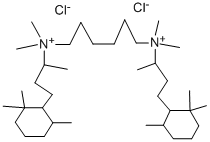triclobisonium chloride
- CAS NO.:79-90-3
- Empirical Formula: C36H74N2.2Cl
- Molecular Weight: 605.901
- MDL number: MFCD00865978
- EINECS: 201-232-7
- SAFETY DATA SHEET (SDS)
- Update Date: 2023-04-23 13:52:06

What is triclobisonium chloride?
Originator
Triburon,Roche,US,1959
Manufacturing Process
To a solution of 49 grams (0.25 mol) of cis-tetrahydroionone and 14.1 grams
(0.12 mol) of 1,6-hexanediamine in 150 ml of ethanol was added 1 teaspoon
of Raney nickel. The volume was adjusted to 300 ml with ethanol and the
mixture was hydrogenated at 50°C and a pressure of 200 psi. The catalyst
was filtered off, the filtrate was concentrated and the residual oil fractionated
in vacuo to obtain N,N'-bis[1-methyl-3-(2,2,6-trimethylcyclohexyl)propyl]-1,6-
hexanediamine; BP 192° to 202°C at 0.02 mm.
To 217 grams (0.456 mol) of N,N'-bis[1-methyl-3-(2,2,6-
trimethylcyclohexyl)propyl]-1,6-hexanediamine were added 182 ml (3.04
mols) of formic acid (90%). The resulting colorless solution was cooled, then
91.3 ml (1.043 mols) of formaldehyde (37%) were added. The solution was
heated at steam temperature with occasional shaking for 2 hours and then
refluxed for 8 hours. The volatiles were distilled off at steam temperature
under water vacuum and the residual oil was made strongly alkaline with 50%
potassium hydroxide. The reaction product was extracted with ether. The
ether extract was washed with water, dried and concentrated in vacuo. The
residual oil was fractionated in vacuo to obtain N,N'-bis[1-methyl-3-(2,2,6-
trimethylcyclohexyl)propyl]-N,N'-dimethyl-1,6-hexanediamine, BP0.4 230° to
240°C, nD26 = 1.4833. An aliquot, when treated with an ethanolic hydrogen
chloride, gave the crystalline dihydrochloride, MP 183° to 185°C (recrystallized
from ethanol-acetonitrile).
To 5 grams of N,N'-bis[1-methyl-3-(2,2,6-trimethylcyclohexyl)propyl]-N,N'-
dimethyl-1,6-hexanediamine dissolved in 100 ml of methanol, at 4°C. were
added 100 ml methanol containing 10 grams of methyl chloride. The solution
was heated in a closed vessel at 60°C for 15 hours. The colorless solution was concentrated and the resulting white solid crystallized from ethanol_x0002_acetonitrile-ether to obtain N,N'-bis[1-methyl-3-(2,2,6-
trimethylcyclohexyl)propyl]-N,N'-dimethyl-1,6-hexanediamine
bis(methochloride) hemihydrate.
Therapeutic Function
Antiseptic
Safety Profile
Poison by ingestion,subcutaneous, intravenous, and intraperitoneal routes.When heated to decomposition it emits toxic fumes of Clíand NOx.
Properties of triclobisonium chloride
| Melting point: | 243-253° (dec) |
| color | White, crystalline powder |
Safety information for triclobisonium chloride
Computed Descriptors for triclobisonium chloride
New Products
Indole Methyl Resin tert-butyl 9-methoxy-3-azaspiro[5.5]undecane-3-carboxylate Boc-His(Boc)-OH 2-CTC Resin 4-Chloro-7-tosy1-7Hpyrrolo[2,3-d]pyrimidine 5,7-Dibromo-1H-indole 2,5-dichloro-N-hydroxy-4,6-dimethylpyridine-3-carboximidamide 2,2-Dimethoxy-7-azaspiro[3.5]nonane hydrochloride 4-chloromethyl-5-methyl-1,3-dioxol-2-one (DMDO-Cl) R-2-BENZYLOXY PROPIONIC ACID 1,1’-CARBONYLDIIMIDAZOLE 1,1’-CARBONYLDI (1,2-4 TRIAZOLE) N-METHYL INDAZOLE-3-CARBOXYLIC ACID 4-((2-hydroxyethyl)thio)benzoic acid 1-(TERT-BUTOXYCARBONYL)-2-PYRROLIDINONE Methyl 6-methylnicotinate 3-Pyridineacrylic acid tert-Butyl carbazate TETRAHYDRO-2H-PYRAN-3-OL 2-((4-morpholinophenylamino) (methylthio) methylene) malononitrile 3-(4-morpholinophenylamino)-5-amino-1H-pyrazole-4-carbonitrile 2,4-dihydroxybenzaldehyde 1,3-Diethyl-1,3-Diphenylurea Methyl 2-methylquinoline-6-carboxylateRelated products of tetrahydrofuran
You may like
-
 Pyridine 99.5% HPLC /UV SpectroscopyView Details
Pyridine 99.5% HPLC /UV SpectroscopyView Details
110-86-1 -
 Guanine , 99%View Details
Guanine , 99%View Details
73-40-5 -
 Piperazine Spot supply, best priceView Details
Piperazine Spot supply, best priceView Details
110-85-0 -
 Potassium Hydroxide 90%View Details
Potassium Hydroxide 90%View Details
1310-58-3 -
 Dibutyl PhthalateView Details
Dibutyl PhthalateView Details
84-74-2 -
 Imidazole Spot supply, competitive priceView Details
Imidazole Spot supply, competitive priceView Details
288-32-4 -
 Octadecyl 3-(3,5-di-tert-butyl-4-hydroxyphenyl)propionate 98% (GC)View Details
Octadecyl 3-(3,5-di-tert-butyl-4-hydroxyphenyl)propionate 98% (GC)View Details
2082-79-3 -
 Thiourea 99% ARView Details
Thiourea 99% ARView Details
62-56-6

